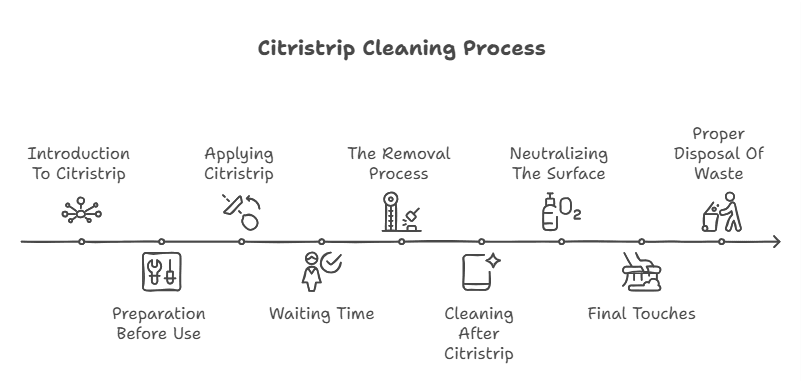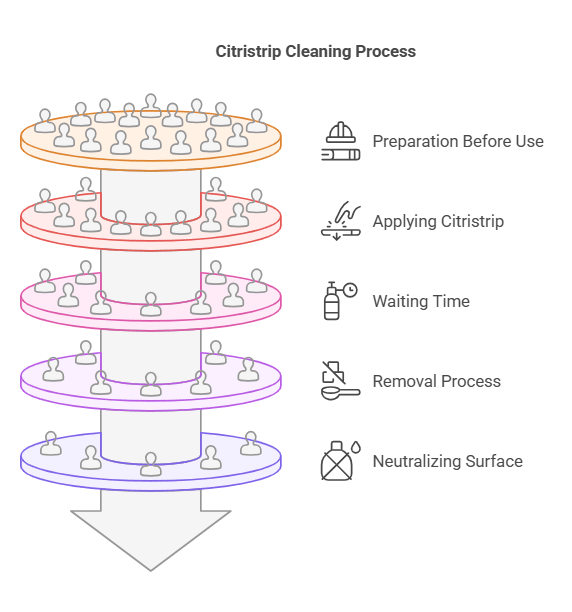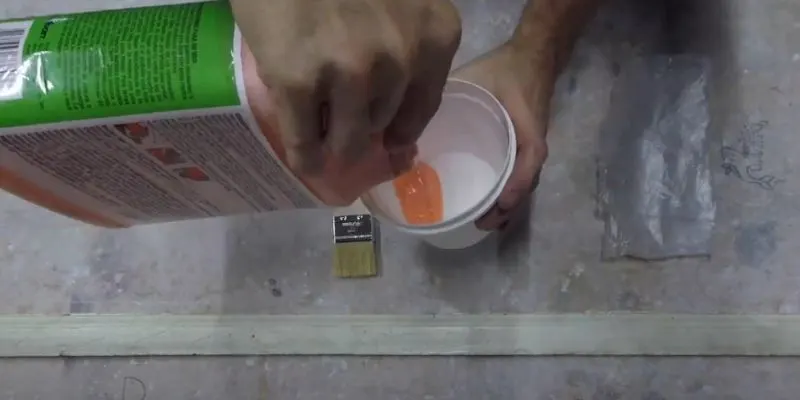To clean off Citristrip, use a clean cloth or scraper to remove residue. Rinse the surface with water to ensure all chemicals are gone.
Citristrip is a powerful paint and varnish remover, popular for its effectiveness and citrus scent. Many DIY enthusiasts appreciate its ability to penetrate stubborn finishes without harsh chemicals. However, removing Citristrip residue can be tricky if not done correctly. Proper cleaning ensures a smooth surface for painting or refinishing.
Knowing how to clean off Citristrip effectively can save you time and effort in your projects. This guide will walk you through simple yet effective steps to eliminate any lingering residue, allowing you to achieve a clean and ready surface for your next endeavor.
Introduction To Citristrip
Citristrip is a popular paint remover. It is safe and effective for many surfaces. This product uses natural citrus terpenes. These terpenes break down paint easily.
Choosing Citristrip makes sense for several reasons. First, it is less toxic than many alternatives. Second, it does not have strong, harsh odors. Finally, it works well on different surfaces, including wood and metal.
For those who want to remove paint safely, Citristrip is a great choice. It is easy to use and provides excellent results. Many people trust this product for their home projects.
Preparation Before Use
Cleaning off Citristrip requires careful preparation. Start by putting on protective gear. This includes gloves, goggles, and a mask. These items protect your skin, eyes, and lungs from harmful chemicals.
Gather all necessary tools before starting. You will need a scraper, brush, and rags. A bucket for water and a drop cloth can also be helpful. Make sure to have a ventilated area for your work. This keeps the air fresh and safe.
Having everything ready makes cleaning easier. Always prioritize safety during the process. This ensures a smooth and effective cleaning experience.

Applying Citristrip
To achieve even coverage with Citristrip, follow these steps. First, choose a clean surface to apply the product. Use a brush or roller for application. Make sure to cover all areas evenly.
Apply a generous amount of Citristrip. Avoid thin layers as they may not work well. Allow it to sit for the recommended time. This ensures the product penetrates properly.
Check the surface. If needed, apply another layer. Use a scraper to remove the finish after the time is up. This will help achieve a smooth surface.
Always wear gloves and work in a well-ventilated area. Clean tools with soap and water after use. Following these tips will help ensure a successful removal.
Waiting Time
Wait at least 30 minutes after applying Citristrip. This time allows the product to work effectively. Signs that Citristrip is ready for removal include a gel-like consistency. The paint or finish should look wrinkled and softened. If it appears shiny, it is time to scrape it off. Check the edges; they may start to lift. If parts remain hard, wait a bit longer. Always test a small area first. This ensures the best results without damage.
The Removal Process
To effectively scrape off Citristrip, use a plastic scraper. This tool prevents damage to surfaces. Hold the scraper at a low angle. Apply gentle pressure to avoid scratches.
For stubborn areas, a fine steel wool pad can be useful. Moisten the pad with a little Citristrip. This helps lift tough residues without excessive force. Always test a small area first.
Using a soft cloth soaked in mineral spirits also helps. Wipe the area gently to loosen any remaining product. Repeat until the surface is clean.
Remember to wear gloves and a mask for safety. Citristrip has strong fumes that can irritate. Working in a well-ventilated area is also important.
Cleaning After Citristrip
Choosing the right cleaning solvent is essential. Citristrip can leave behind residue. Use mineral spirits or denatured alcohol for best results. Always test the solvent on a small area first.
Wiping down the surface helps remove any leftover product. Use a soft cloth or rag. Dampen the cloth with your chosen solvent. Wipe gently but firmly to avoid damage. Rinse the cloth often to keep it clean.
After cleaning, allow the surface to dry completely. This ensures no moisture remains. Check for any spots that may need extra attention.
Neutralizing The Surface
Neutralizing the surface after using Citristrip is very important. This process helps remove any remaining chemicals. Proper neutralization protects your surfaces and ensures safe handling.
To neutralize effectively, follow these steps:
- Use a pH-neutral cleaner or a vinegar solution.
- Apply the cleaner with a soft cloth or sponge.
- Scrub gently to remove any residue.
- Rinse the surface thoroughly with clean water.
- Dry the area with a clean towel.
Always wear gloves and goggles for safety. Make sure the area is well-ventilated. This helps to avoid inhaling any harmful fumes.
Final Touches
After using Citristrip, the final touches are important for a great finish. Start with sanding the surface. Use fine-grit sandpaper for the best results. Sand in a circular motion to avoid scratches.
Check the surface for any remaining residue. A smooth finish feels nice and looks good. Use a clean cloth to wipe away any dust. This helps see the true quality of the surface.
If there are rough spots, sand them again. Ensuring a high-quality surface leads to better finishing products. Always remember to wear a mask while sanding to protect your lungs.

Proper Disposal Of Waste
Proper disposal of Citristrip is important for the environment. Always read the label for disposal instructions.
Citristrip contains chemicals that can harm nature. Never pour it down the sink or toilet.
Use a sealed container for leftover Citristrip. Take it to a local hazardous waste facility. Many towns have special days for this.
Check with your local waste management for their rules. Safe disposal helps keep our water and air clean.
Remember, proper disposal protects wildlife and our planet. Make sure to follow all safety guidelines.
Troubleshooting Common Issues
Residue problems may occur after using Citristrip. This can happen for various reasons. It might be due to improper application or not enough dwell time. Follow these steps to solve residue issues:
- Scrape off excess residue with a plastic scraper.
- Use a clean cloth soaked in mineral spirits.
- Wipe the surface thoroughly.
- For stubborn spots, apply more Citristrip.
- Let it sit longer before scraping again.
Sometimes, Citristrip doesn’t remove all the finish. In such cases, repeat the application. Always ensure proper ventilation while working. This helps in better performance and safety.
Preventive Measures For Future Projects
Using protective coatings on surfaces can help maintain their appearance. Regularly inspecting painted areas prevents damage. Clean surfaces often to avoid build-up of dirt and grime.
Choose high-quality paints for durability. Applying a fresh coat every few years protects the underlying surface. Avoid using harsh chemicals that can damage the paint.
Store items properly to prevent scratches. Use coasters under furniture to protect painted surfaces. Cover areas during renovations to keep them safe from dust and debris.

Frequently Asked Questions
How Do You Remove Citristrip From Surfaces?
To remove Citristrip, start by scraping off the residue using a plastic scraper. Follow this by applying a clean cloth soaked in mineral spirits or water. Wipe the area thoroughly until clean. Ensure proper ventilation during the process and wear gloves for safety.
Can You Use Citristrip Indoors?
Yes, you can use Citristrip indoors, but precautions are necessary. Ensure proper ventilation by opening windows and using fans. Wear protective gear, such as gloves and masks, to avoid inhaling fumes. Always follow the manufacturer’s instructions to ensure safe usage.
What Is Citristrip Used For?
Citristrip is primarily used for removing paint, varnish, and other finishes from various surfaces. It works effectively on wood, metal, and masonry. This product is popular for its citrus-based formula, which is less toxic than traditional paint strippers, making it a safer choice for DIY projects.
How Long Does Citristrip Take To Work?
Citristrip typically takes between 30 minutes to 24 hours to work, depending on the thickness of the finish being removed. For best results, allow it to sit longer on stubborn areas. Always test a small patch first to determine the optimal time for your specific project.
Conclusion
Cleaning off Citristrip can seem daunting, but it doesn’t have to be. Following the right steps makes the process simple and effective. Always prioritize safety and use the proper tools. With practice, you’ll master this technique. Enjoy your refreshed surfaces and the satisfaction of a job well done.
Happy stripping!

